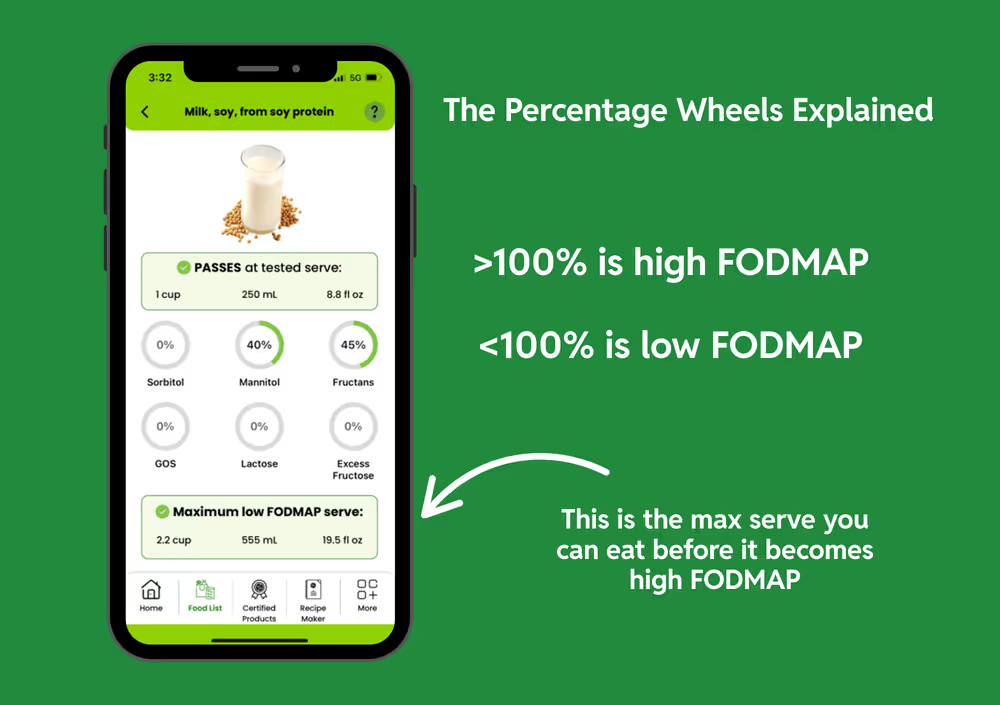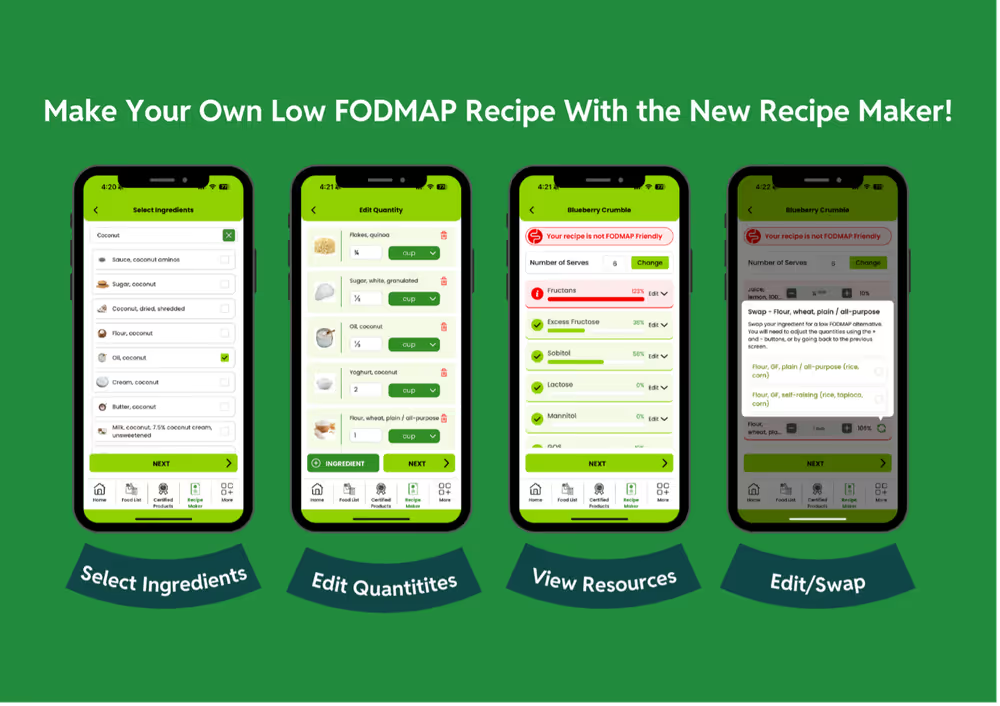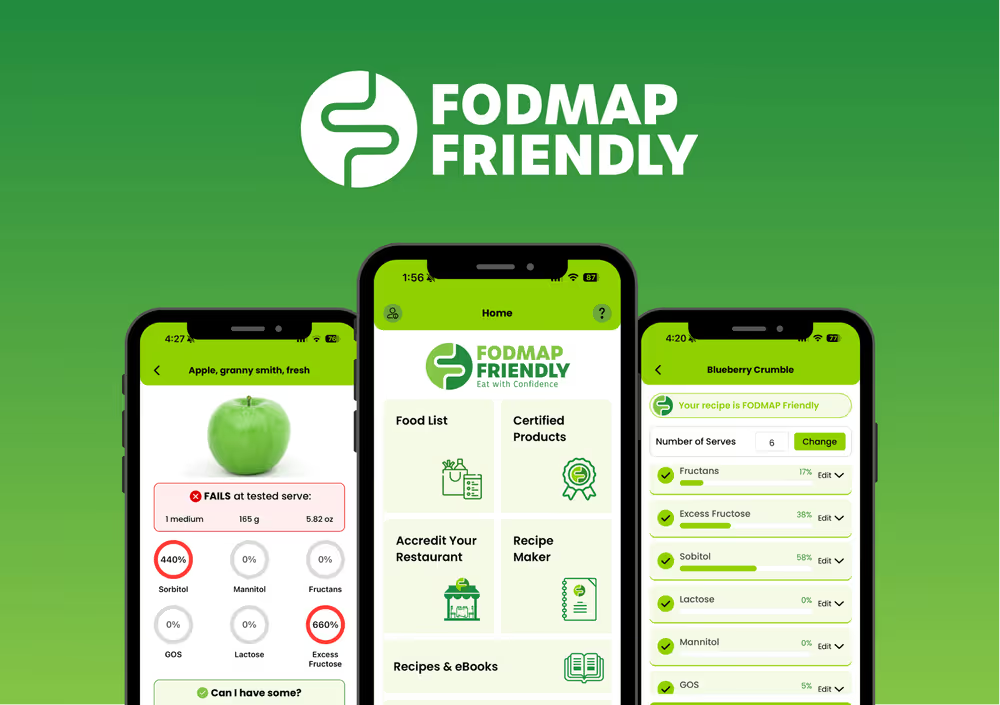FODMAP Friendly are innovators in the low FODMAP space and were the first low FODMAP certification in the world, co-founded in 2012 by Dr Sue Shepherd, one of the team of researchers of the low FODMAP diet.
In the past decade, they have certified thousands of products around the world, including FODZYME, and share these with their consumers via their app, website, monthly newsletters and social media platforms.
In addition to their certification, they have lab tested thousands of individual ingredients, including fruits, vegetables, grains, nuts and more.
Most recently, FODMAP Friendly has utilized this database of ingredients to develop a new Recipe Maker tool that allows app users to create their own low FODMAP recipes. A handy recipe analyzer function then calculates FODMAP stacking within a FODMAP group for you and informs you if your recipe exceeds FODMAP limits.
In this blog we will explain the different features of the FODMAP Friendly app, what is FODMAP stacking, and how you can use FODZYME when cooking to enjoy a low FODMAP meal at home.

Looking up foods
Using the FODMAP Friendly app, you can search individual ingredients or foods to learn their FODMAP content. For example, if you think soy milk may trigger your symptoms, you can search for ‘soy milk’ in the app and learn the types of FODMAPs it contains, as well as the maximum low FODMAP serve size.
Foods are represented by their tested serve size. This serve size is based on an average serve, for example, 1 cup of milk, or 1 whole apple. The food will either PASS or FAIL at that serve size.
The ‘percentage wheels’ show how much of each FODMAP is present in the serving size, expressed as a percentage of the maximum allowed amount you can consume. Anything over 100% is considered high FODMAP and will FAIL.
If a food PASSES, it means the tested serve is low FODMAP and suitable to eat. In some cases, you may even be able to eat more than the tested serve. To find out, scroll to the bottom of the screen, where the app shows the maximum low FODMAP serve. For example, soy milk passes at 1 cup, but you’ll see at the bottom of the screen that you can actually have just over 2 cups before it becomes high FODMAP!

If a food FAILS, it means the tested serve is high in FODMAPs. However, that doesn’t always mean you need to avoid it completely. Scroll to the bottom of the screen to check if a smaller low FODMAP serve is listed as you may still be able to enjoy a reduced portion without triggering symptoms.
‘Eat Freely’ means that you can consume larger amounts of this food because it either contains no FODMAPs, or no FODMAPs were detected in the tested sample.

Determining foods to use with FODZYME
Once you know the type of FODMAPs in a food, cross-check those FODMAPs with the ones that FODZYME targets, which are the fructan, GOS/galactans and lactose. Fructan and GOS/galactans are in the oligosaccharide FODMAP family, or the "O," while lactose is in the disaccharide family, the "D".
If the food is high in any of these three FODMAPs (fructan, GOS, lactose), then FODZYME can help you tolerate it.
We know that people don’t consume food in isolation but eat many foods together as ingredients that make up a complete meal. So, what happens to the FODMAP content then? Something called ‘FODMAP stacking’ occurs, which could be the reason why you might still be experiencing symptoms after a meal. Below we will explain why this occurs, and how FODZYME can help you consume complete meals with confidence.

What is FODMAP stacking?
FODMAP stacking occurs when multiple low FODMAP ingredients are combined in a meal, causing the overall FODMAP load to exceed the low FODMAP threshold. Whilst they may be low FODMAP in their individual serves in isolation, it is the addition of FODMAPs that “stack up” and cause the recipe or meal to become high FODMAP and trigger symptoms.
For example, as mentioned above, soy milk is low FODMAP at 1 cup and remains low up to around 2.2 cups, at which point it becomes high in fructans. One slice of bread is also low FODMAP on its own. However, if you have 1 cup of soy milk and a slice of bread in the same meal, the combined amount of fructans exceeds the low FODMAP limit, even though each food individually passes, and could trigger symptoms due to FODMAP stacking.
Making a Recipe with the FODMAP Friendly recipe Maker
The Recipe Maker feature calculates FODMAP stacking within a FODMAP group for you. You can use a recipe that already exists to check if it is low FODMAP, or you can create one from scratch

- From the Recipe Maker homepage, select Make a Recipe. Here you can enter the name and number of serves. Then click next.
- Select Ingredients: Search for ingredients by typing in the search bar or browse through categories.
- Edit Quantities: Adjust the amounts of each ingredient as needed for your recipe. Click next.
- View Results: The results page shows the analysis of your recipe by calculating FODMAP stacking within each FODMAP group and will tell you whether your recipe is FODMAP Friendly or not. If any FODMAP category is highlighted in red, it indicates that the recipe has failed due to one or more ingredients contributing to stacking and causing the meal to be high FODMAP. (Tip: select the drop-down arrow to find which ingredients were the culprits!)
- Swap/Edit: You have the option to lower the amount of the high FODMAP ingredient using the + or – signs OR swap the high FODMAP ingredient(s) for a low FODMAP alternative to make your recipe low FODMAP.
If the recipe is high fructans, GOS, or lactose, then FODZYME can help you tolerate it.
If there’s an ingredient in the recipe you don’t want to swap—whether it adds flavor, creaminess, or helps bind the dish—you don’t have to change it! FODZYME allows you to enjoy the recipe as is, without the need for substitutions.
In the Save Recipe page, simply add in your method that you will add FODZYME before consuming, as a reminder that this recipe can be low FODMAP.

NOTE: If following the three-phased low FODMAP diet approach, FODZYME should be used during phase three, the personalization phase of a low FODMAP diet (use of FODZYME during phases one and two of the low FODMAP diet may hinder understanding of your personal FODMAP triggers). If using FODZYME prior to a low FODMAP diet or as an alternative, FODZYME can be used with known or suspected FODMAP triggers high in fructan, GOS and/or lactose.
Finding a Dietitian
While the FODMAP Friendly app and FODZYME can be incredibly helpful for managing symptoms, working with a dietitian can make a big difference especially when you are navigating FODMAP stacking, trialling new ingredients, or figuring out when and how to use FODZYME effectively. The low FODMAP diet is recommended to be followed under the guidance of a dietitian, as they can help personalize the approach to suit your needs and ensure you are meeting your nutritional requirements.
Using the Find a Dietitian feature inside the FODMAP Friendly app makes it easy to locate a dietitian near you that specialises in gut health. Filter by country, state, or city, or use the interactive map to locate a dietitian near you. Having personalised support can help you feel more confident and in control of your FODMAP journey.



 FODZYME Research
FODZYME Research